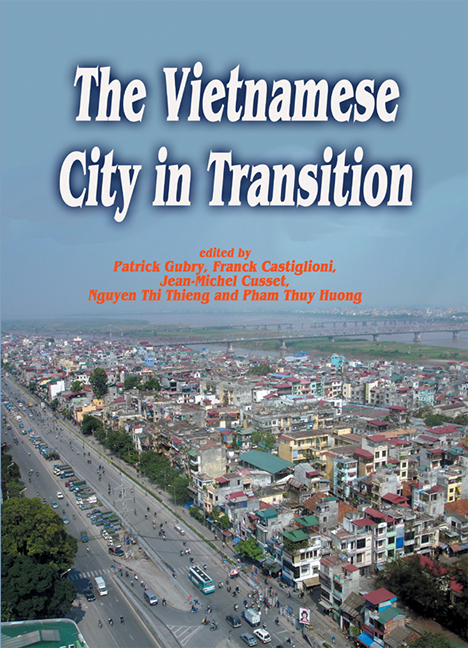Book contents
- Frontmatter
- Contents
- List of Tables
- List of Figures
- List of Colour Plates
- Foreword
- Acknowledgments
- List of Acronyms
- The Editors
- The Contributors
- Introduction: Urban Research in Action: Context, Aims, Directions
- 1 Urban Transition in Vietnam: Its Processes and Stakeholders
- 2 Road System and Urban Recomposition in Hanoi
- 3 Intra-Urban Mobility in Ho Chi Minh City and Hanoi
- 4 Resettlement Issues of Informal Settlement Areas in Ho Chi Minh City: From Large-scale Programmes to Micro-projects
- 5 Changes in Public Water Management: Transition, Compromise, and Innovation
- 6 The Role of Civil Society in Urban Environmental Management
- 7 Assessment of Projects Supported by Official Development Assistance Based on Partnership Formats: From Ho Chi Minh City to Hanoi
- 8 Relations between International Consultants and the Local Engineering Force in Urban Infrastructures
- 9 Conclusion: A Diverse Approach to Research on Urban Issues
- General Bibliography
- Index
- Plate Section
4 - Resettlement Issues of Informal Settlement Areas in Ho Chi Minh City: From Large-scale Programmes to Micro-projects
Published online by Cambridge University Press: 21 October 2015
- Frontmatter
- Contents
- List of Tables
- List of Figures
- List of Colour Plates
- Foreword
- Acknowledgments
- List of Acronyms
- The Editors
- The Contributors
- Introduction: Urban Research in Action: Context, Aims, Directions
- 1 Urban Transition in Vietnam: Its Processes and Stakeholders
- 2 Road System and Urban Recomposition in Hanoi
- 3 Intra-Urban Mobility in Ho Chi Minh City and Hanoi
- 4 Resettlement Issues of Informal Settlement Areas in Ho Chi Minh City: From Large-scale Programmes to Micro-projects
- 5 Changes in Public Water Management: Transition, Compromise, and Innovation
- 6 The Role of Civil Society in Urban Environmental Management
- 7 Assessment of Projects Supported by Official Development Assistance Based on Partnership Formats: From Ho Chi Minh City to Hanoi
- 8 Relations between International Consultants and the Local Engineering Force in Urban Infrastructures
- 9 Conclusion: A Diverse Approach to Research on Urban Issues
- General Bibliography
- Index
- Plate Section
Summary
Research Presentation
The present research is the outcome of multi-disciplinary teamwork between Lausanne Federal Polytechnic School–LaSUR Laboratory (Switzerland), the Centre of Sociology and Development (Vietnamese centre for sociology research based in Ho Chi Minh City) and the French NGO Villes en Transition or VeT (Cities in Transition), which managed a resettlement pilot project in Ho Chi Minh City in 2000. This project is the object of the present research.
The theoretical framework for this study consists in analysing the implementation and impact of large-scale resettlement operations in Ho Chi Minh City and of a resettlement micro-project carried out by VeT.
The methodology used for this research consists mainly of semi-directive interviews with the resettled people themselves, with social service providers from Vietnamese mass organizations, and with political and technical decision-makers involved in the resettlement operations studied.
This research has been an opportunity for exchanges as well as disagreements between stakeholders from diverging backgrounds as resettlement and its attendant issues are particularly sensitive in Vietnam.
The requirements of urbanization and the need to improve the environment and living conditions of disadvantaged populations have led to planned resettlement operations in Ho Chi Minh City. The large-scale programme for Nhieu Loc-Thi Nghe canal and the micro-project for the Binh Trung Dong ward (District 2) exemplify this.
Within this framework, we have focused on measuring the socioeconomic impact of resettlement operations: that is to say, the mechanisms which generate socioeconomic effects, whether they are socially beneficial or detrimental.
Our objective was not to establish a comparative analyse stricto sensu between large-scale programmes and a resettlement micro-project so as to determine which approach works best, since it is difficult to establish elements of comparison between an operation covering a population of about 20,000 households and a micro-project concerning a mere fifty-five households.
Information
- Type
- Chapter
- Information
- The Vietnamese City in Transition , pp. 101 - 132Publisher: ISEAS–Yusof Ishak InstitutePrint publication year: 2010
